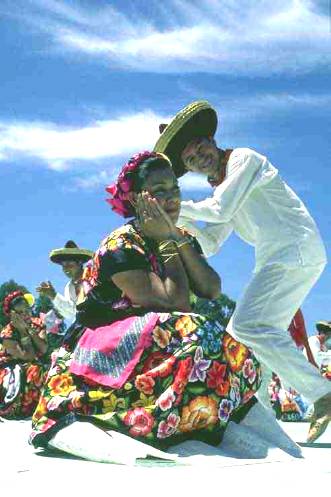

 Oaxaca's Gift to the World
Oaxaca's Gift to the World
La Guelaguetza is the city of Oaxaca's most important cultural festival of the year. Held on the two consecutive Mondays following the festival of the Virgin of Carmen (July 16), it is also known as los Lunes del Cerro, or Mondays of the Hill.
It brings together the indigenous cultures from all the regions of Oaxaca to proudly display their unique traditions through music and dance, song and ceremony.
The city is always an interesting cradle of cultures, but during Lunes del Cerro the city is positively vibrating with sights, sounds, smells and excitement. The Zócalo is crammed with arts and crafts, food stalls are everywhere and parades of fabulously bedecked participants seem to take place constantly.
A Zapotec word signifying offering, Guelaguetza was the term used to describe the Oaxacan ceremony and celebration held each year to appease the gods in return for sufficient rain and a bountiful harvest.
This offering of life's gifts took place midway through the rainy season, when it was essential that the rains continue moderately and without excess to bring forth the best crops. The feast of Xilonen, goddess of tender corn, falls in this period on what in the modern calendar is July 16 and is the signal to begin the two weeks of celebration.
When the Spanish arrived in Oaxaca in 1521 they converted all the indigenous people and imposed the Catholic religion. One of their tactics was to "convert" to Catholic ways the deeply rooted customs honoring pagan beliefs. For example, razing temples and building churches on the ruins, conserving the holiness of the place but identifying it with the new religion.
In the case of the Guelaguetza, the idea was to change it to a celebration of the feast on July 16 of the Virgin of Carmel and that is why the Guelaguetza begins with the traditional calenda parades from the church of Carmen Alto.
Overlooking the present city of Oaxaca is the hill now known as the Cerro del Fortín from the location of Aztec garrisons there in the 15th century.
This Cerro was a very popular place for outings and came to be the traditional place for celebrating the Mondays on the Hill, when the Guelaguetza began to focus on the celebrations held on the two Mondays following July 16.
The festival endured through colonial and pre-Revolutionary times. Then in 1932, as part of the celebration of the 400th anniversary of the founding of the city of Oaxaca, groups from all the regions of the state paid homage to their capital with a great festival of dance, music and presentation of their particular traditions. In 1974 a special auditorium was opened on the Cerro to seat 11,400 spectators to accommodate the performances.
Mondays on the Hill this year are July 21 and 28. Tickets sell out fast, but there are a multitude of other activities that take place in the city, many of which are free.
 The major events get started on Saturday the 18th at 10:30 a.m. on the
south side of the Santo Domingo Church with the contest to elect the
Diosa Centeotl (Corn Goddess) from among the different regional
delegations to the Guelaguetza. At 6 p.m. that evening there is a
procession of all the participating delegations, which winds through the
downtown with music and fireworks.
The major events get started on Saturday the 18th at 10:30 a.m. on the
south side of the Santo Domingo Church with the contest to elect the
Diosa Centeotl (Corn Goddess) from among the different regional
delegations to the Guelaguetza. At 6 p.m. that evening there is a
procession of all the participating delegations, which winds through the
downtown with music and fireworks.
Later you can join the Mescal Fair procession. at 7:30 p.m. that same evening starting at the corner of Macedoneo Alcalá and Beriozabal. The fair continues through the end of the month.
Every evening there are concerts, theater and dance in different parts of the city especially in Jardin el Pañuelito, on the Andador Turistico (Macedoneo Alcalá), at the Zocalo, in the atrium of the Santo Domingo church and the Plaza de la Danza, where at 8:30 p.m. the Sunday evenings before the Lunes del Cerro there is the Bani-Stui-Gulal which is a recreation of the history of the Guelaguetza from prehispanic times to the present.
On both Monday nights at 8:30 is the presentation of the Legend of Princess Donají pageant. This is the telling of the founding myth of the city of Oaxaca. Donají was a Zapotec princess who was held as a hostage by the Mixtecs to ensure peace and cooperation between the two rival nations.
Like Verdi's Aida, this heroine suffered a tragic destiny: she chose to risk death and forever lose her lover, the Mixtec prince Nucano, rather than betray her people.
Donají secretly aided a Zapotec attack that failed to free her. In reprisal she was beheaded; her lover Nucano buried her.
According to legend, death did not deprive Donají of her beauty, which endures to this day as she rests, beside Nucano, in temple of Culiapan de Guerrero.
Today the image of the severed head of Donají is the official symbol of
the city of Oaxaca.